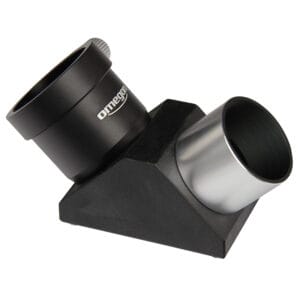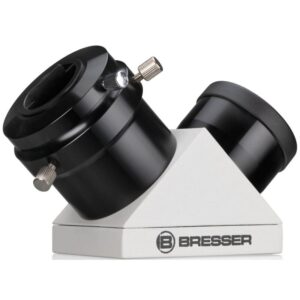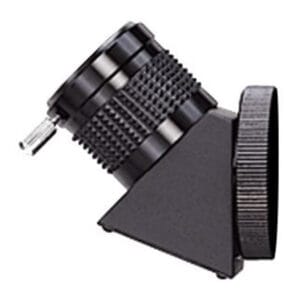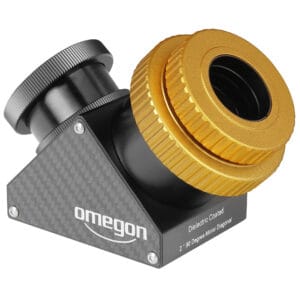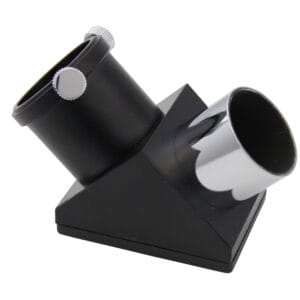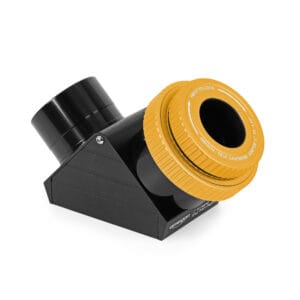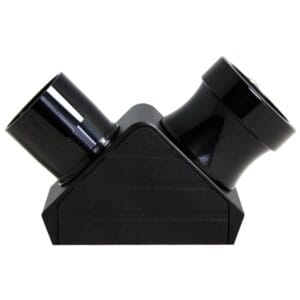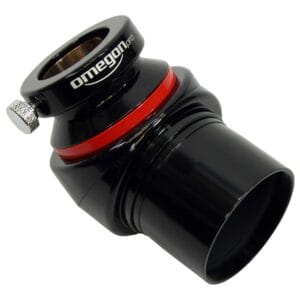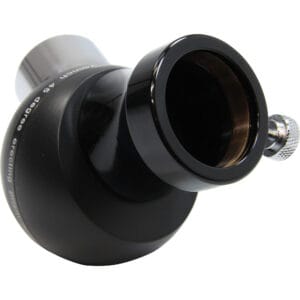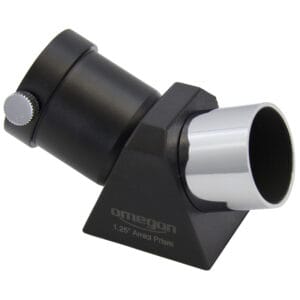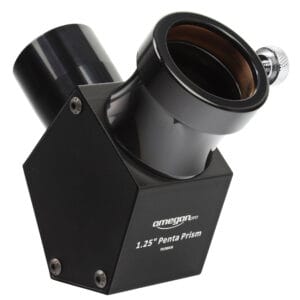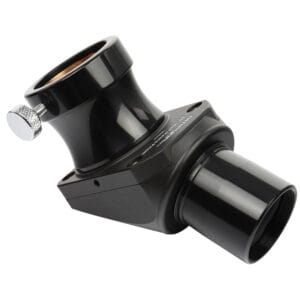Diagonals
More comfortable viewing at any angle
A diagonal mirror or prism bends the light path of your telescope so you can observe more comfortably. Choose from standard, 90° or Amici diagonals, all direct from stock and delivered within 48 hours.
Showing all 16 resultsSorted by popularity
Showing all 16 resultsSorted by popularity
Diagonals
Diagonals are the link between your focuser and eyepiece and determine how you look through the telescope. Inverting the image by 90° or 45° prevents neck pain and allows you to observe longer comfortably, especially with objects high in the sky. In this guide, you'll discover all about types, coatings, installation and maintenance.
1. Function and ergonomics
Comfortable viewing: a 90° diagonal keeps your neck in a neutral position; 45° is more compact and more desirable at low elevations.
Image correction: high-quality prisms or mirrors ensure that orientation does not compromise sharpness or light transmission.
2. Mirror type vs. Prism type.
| Feature | Mirror-diagonal | Prism diagonal |
|---|---|---|
| Light transmission | ≈ 95-98% (more reflections) | ≈ 98-99% (less saturation) |
| Contrast & color | Tendency to slight color cast | Accurate color fidelity |
| Sustainability | Good resistance to temperature fluctuations | Glass prisms are more susceptible to scratching |
| Maintenance | Easy to clean | Prism surfaces require careful cleaning |
3. Angle selection: 90° vs. 45°
90° diagonals
- Standard for most telescopes and comfortable for visual use.
- A little more weight and length in the optical chain.45° diagonals
- Suitable for refractors and EAA setups where you occasionally work in low field of view.
- Less obstruction near the focuser.
4. Build quality and coatings
Multi-coatings (≥98% transmission per surface) minimize reflection losses and ghosting.
FPL-53 / BAK4 glass in prisms for maximum resolution and sharpness, no internal reflection.
CNC-machined housing with Delrin collar protects against scratches and simplifies assembly.
5. Installation and best practices.
Stable mounting: Clamp the diagonal firmly, but not too tightly; over-lubrication can cause slack.
Backfocus check: Each diagonal adds 10-20 mm; measure beforehand and adjust your chain.
Cleaning: Use a blower, soft brush and microfiber cloth with optical cleaner; touch prism surfaces as little as possible.
6. Maintenance and storage
Protective cap: always place lens and eyepiece caps after use.
Silica gel: put a few bags in your diagonal case to prevent condensation.
Case: Store in a foam-inlay lined bag or case to absorb shock.
Frequently Asked Questions about Diagonals
What type of diagonal do I choose for planetary versus deep-sky?
For planetary viewing, prefer a prism diagonal (no color cast); for deep-sky, a mirror diagonal is often adequate.Does a 90° diagonal lose a lot of light?
Modern multi-coatings limit reflection loss to 2-5% per mirror plane, thus minimal impact.How much backfocus does a diagonal add?
Between 10 and 20 mm, depending on types and manufacturer; always measure in your optical chain.Is a 45° diagonal suitable for high magnifications?
Yes, but beware of additional internal reflections; opt for a high-quality multi-coating.How do I clean a prism diagonal?
Blow with a rubber bellows, then gently with a lint-free cloth and a few drops of optical cleaner.Can I combine a diagonal with a Barlow?
Yes, always mount the Barlow before the diagonal to maintain back focus and focus range.What is the advantage of BAK4 glass in diagonal prisms?
BAK4 has a higher refractive index, gives less internal scattering and sharper edge contrast.How do I prevent backlash in my diagonal?
Use a Delrin collar with gentle pressure, tighten clamping ring just enough for stability without binding.Does a diagonal cause astigmatism?
Poor quality prisms can introduce astigmatism; choose branded prisms with high tolerances.Should I have my diagonal mounted outside in cold weather?
No; cold glass surfaces attract condensation, use a dew-shield or heater tape.Why do I sometimes feel a color cast?
Due to incomplete or single coatings; invest in multi-coated models.Can I keep my diagonal in a drawer?
Only if it is foam-filled and remains dust- and moisture-free.How do I know that my diagonal is properly aligned?
Collimate via a Cheshire mirror after the diagonal is installed; correct deviations.Does excessive tightening damage the housing?
Yes, too much force can scratch the anodization layer; turn to light resistance.Is a 2″ diagonal better than 1¼″?
For widescreen and photography, 2″ is preferable because of higher light transmission and larger eye field.How do I test light transmission of my diagonal?
Compare visually with and without a diagonal at a bright object; a transmission loss <5% is acceptable.Can I use a diagonal in a vertical position?
With prisms, no problem; mirrors can distort due to their own weight-let's make sure you have a sturdy housing.Why doesn't my eyepiece slide properly in the diagonal?
Check that Delrin collar and focusing clamp are clean and not damaged.How much does a high-quality right-coil diagonal weigh?
Average 200-400 g, depending on 1¼″ or 2″ design and housing material.What diagonal is recommended for EAA cameras?
Choose a 2″ prism diagonal with high transmission and waterproof housing for cold nights.


